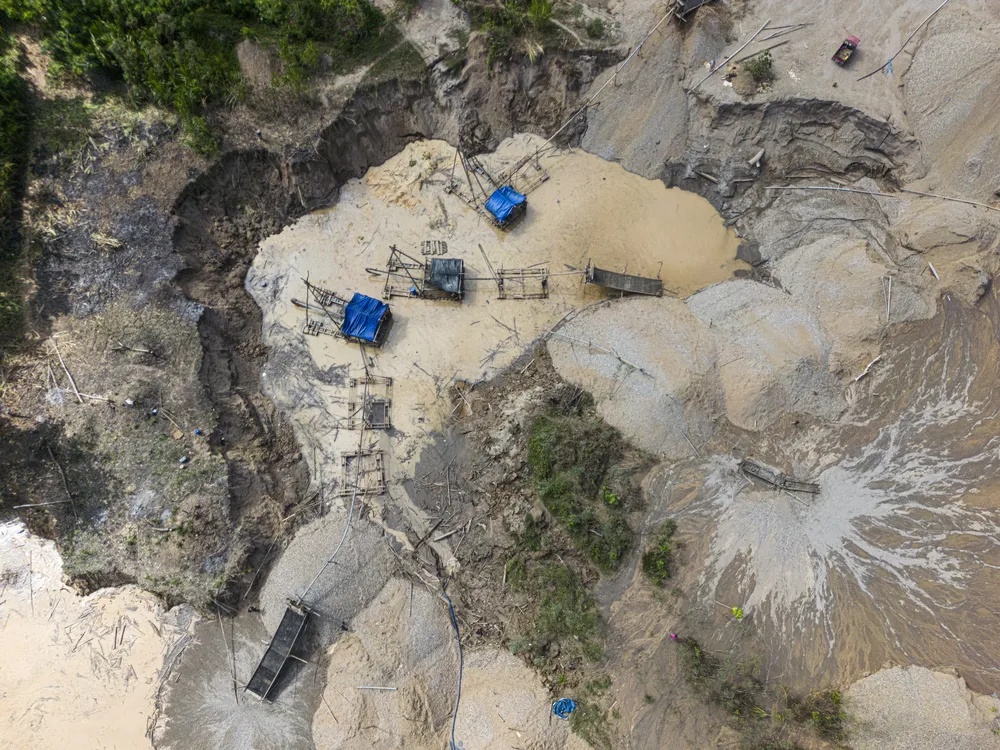Tree Rings Bear Witness to Illegal Gold Mining Operations in the Amazon, New Study Finds
Tree Rings Bear Witness to Illegal Gold Mining Operations in the Amazon, New Study Finds
Mercury concentrations in fig trees could provide useful information about mining activity in the rainforest over time
An aerial view of dredges at an illegal gold mining area in the Amazon region of Peru.
Ernesto Benavides / AFP via Getty Images
Gold mining has ramped up across the Amazon rainforest in recent years, leaving devastated landscapes behind. Small-scale—and usually illegal—mining operations dredge the mineral from subsoil or river sediment. Then, to separate the gold, miners will pour liquid mercury into the soil, forming a hard coating around the coveted mineral. Then, they’ll burn off the mercury to get pure gold.
This process unleashes toxic mercury into the air, making small-scale gold mining worldwide responsible for nearly two-fifths of the planet’s mercury pollution. While these operations provide an important source of income to many locals, they also poison the surrounding environment and negatively impact people’s health.
That mercury also finds its way into trees, according to a study published in the journal Frontiers in Environmental Science
“We could potentially see whether mining is starting to ramp up,” says Jacqueline Gerson, an environmental engineer at Cornell University and the study’s lead author, to James Dinneen at New Scientist.
Gerson and her team took core samples from the trunks of fig trees (Ficus insipida) at five sites in the Peruvian Amazon. Three of those sites were located within about 3.1 miles of towns with known mining activity, while the other two were far from any activity.
Research assistants took cores from fig trees in the Peruvian Amazon to study their rings.
Fernanda Machicao
Mercury levels were highest in the samples collected near mining operations and lower near the more isolated towns. The levels found in the trunks reflected higher atmospheric mercury concentrations, which in that area can be readily linked to gold mining, Gerson says in a statement.
The results also show that mercury concentrations rose after 2000, likely because that’s when gold mining activities started to ramp up in those towns, per the statement. “You can start to go back and see: How did it change when the mining came?” says study co-author Luis Fernandez, executive director of Wake Forest University’s Center for Amazonian Scientific Innovation, to New Scientist. “We’re starting to see that it changed a lot.”
Other studies have also used tree rings to track mercury levels, but not in gold-mining regions of the tropics. “While the technique itself is not new,” Gerson adds in another statement, “we wanted to test its application in places where it’s really hard to put out monitors for atmospheric concentrations, because they’re costly and require energy or need to be changed a lot.” Mercury monitors for remote areas can cost up to $100 each, so studying tree rings is a much cheaper option.
The study authors suggest their findings could be helpful to the United Nations’ Minamata Convention on Mercury, an international treaty to protect humans and the environment from the negative effects of the metal. Using tree rings can allow for regional monitoring efforts beyond the Amazon, says Gerson in a statement.
Fernandez tells New Scientist that his research consortium, the Center for Amazonian Scientific Innovation, which focuses on rainforest restoration and mercury pollution, has had its funding from the United States Agency for International Development (USAID) terminated. He calls that decision counter-productive. “Artisanal gold mining is something that threatens borders,” he says. “It corrupts societies. It is a global source of mercury pollution.”
Get the latest stories in your inbox every weekday.


